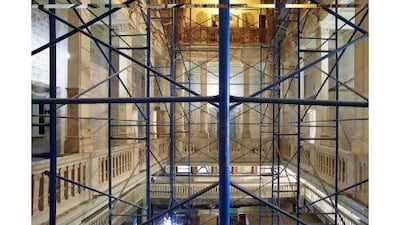The Carswells live in a cottage attached to a 199-year-old lighthouse on the tip of a peninsula in western Scotland.
At night, the beam from the lighthouse sweeps the property, casting an eerie glow across the garden walls and the sea.
"It's quite magical," says Anne Carswell, trying to explain the allure of living next to a lighthouse. "It's a very special place."
Lighthouses are a rare and treasured commodity in the property industry. When they come up for sale, they inevitably attract attention from a devoted group of followers, fans who buy up memorabilia and actively work to preserve the heritage of the lights.
Many of the lighthouses that come on to the market are turned into museums or tourist attractions. But some are converted into private homes, the perfect place for people who like isolation and round rooms. To their fans, lighthouses evoke images of stormy seas and sailing ships navigating treacherous waters.
"People like the romance of the lighthouse," says Rayner Peett, a director at Fine & Country, a property agency in Wales. "For people with the love of sea, it is ideal."
By definition, lighthouses offer dramatic water views and are built to withstand extreme storms.
But putting a price on a lighthouse can be difficult. Many stand on tiny islands or remote headlands far from civilisation. In many cases, they have been in mothballs for decades and might not have any utility connections or modern conveniences.
"Generally, they are bought by individuals who want the extraordinary," says Ran Morgan, the head of Scottish residential property for Knight Frank. "Those relatively accessible from airports will sell better than those in distant locations."
Lighthouses auctioned in the US in recent years have typically sold for between US$30,000 (Dh110,000) and $260,000, says Ralph Conner, the director of property utilisation for the general services administration (GSA), the US government's property agency.
The GSA handles a steady trickle of lighthouses coming on to the market as navigation technology makes them obsolete.
GPS and advanced radar have diminished the need for the lights to warn mariners of navigation hazards, this at a time when the government happens to be looking to trim costs. Each year, about eight to 10 lighthouses come on to the market in the US. Some of them are turned over to non-profit groups and preservation societies at no charge.
But about 25 per cent are auctioned off to people who use the properties for homes or holiday retreats, Mr Conner says.
Each auction usually attracts about five to 15 potential buyer, as news of the available property often spreads through word of mouth and a network of preservation societies.
"The enthusiasm and love of lighthouses is very real," says Mr Conner. "There is a whole culture surrounding it."
Buying a lighthouse usually comes with responsibilities. Many are historic landmarks, and a buyer may be required to preserve the property. Redeveloping the land is often out of the question.
In the US, lighthouses are considered an important part of maritime history. The fate of the properties is dictated by the National Historic Lighthouse Preservation Act of 2000. Lighthouses are "a very important part of culture and tradition", says John Smith, the deputy assistant commissioner for the GSA's property division. "They led the way for trade, and people have sentiment for that."
Battered by the elements, lighthouses are not cheap to maintain, so there is rarely a profit motive for buying them.
"It's usually people with a background in historic preservation," Mr Smith says. "People who are buying are not people who are getting into mortgages."
After 10 years, the Carswells in Scotland are selling their lighthouse to move closer to family. The property, priced at £335,000 (Dh2 million), stands at Toward Point on the Cowal Peninsula, offering panoramic views of the Firth of Clyde.
The Carswells' lighthouse, built in 1812, is the tallest of three towers on the Clyde built by Robert Stevenson, the grandfather of the author Robert Louis Stevenson.
"It's very rare for a lighthouse property in the area to come on the market," says Caroleanne Gallagher, a representative for Savills, the agency handling the sale. "We've never had one before."
The lighthouse tower is not for sale, only the property and the three-bedroom stone cottage, including a sun room and utility room that once served as the lighthouse's radio hub. The Carswells were not lighthouse enthusiasts but fell in love with the property when they stayed at a nearby cottage. From the property, they can watch the steady stream of sailing vessels, ocean liners, oil tankers and the occasional warship passing on the Clyde.
The lighthouse is automated and the foghorn has been disabled, making the light a silent partner to the cottage.
"It's beautifully quiet," says Mrs Carswell's husband, Fleming.

